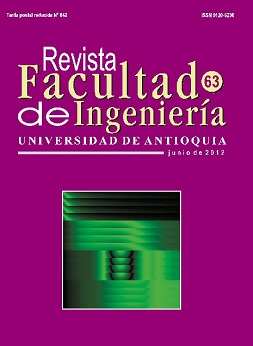A hybrid optimization method for the transmission planning considering different voltage levels
DOI:
https://doi.org/10.17533/udea.redin.12494Keywords:
codification, heuristics, voltage level, optimization, transmission planning, genetic algorithmAbstract
In this article an alternative to solve the transmission network expansion planning problem taking the voltage level as a decision variable is presented. The idea is to benefit from the scale economies which appear when a circuit changes from a preestablished tension level to a higher tension level. Predefine the tension of the new circuits is less effective than taking the tension as one of the quantities that must be defined for the process of alternative’s evaluation. It is proposed a hybrid methodology to reduce the computational effort produced by the exponential growth caused for considering different voltage levels and investment alternatives. In this work, the meta-heuristic technique specifies where should be done the transmission line investments, meanwhile the heuristic techniques and the micro-genetic algorithm specifies the investment in new and existing substations. The developed methodology presented high-quality results.
Downloads
References
G. Latorre, R. Cruz, J. Areiza. “Classification of publications and models on transmission expansion planning”. IEEE Transactions on Power Systems. Vol. 18. 2003. pp. 938-946. DOI: https://doi.org/10.1109/TPWRS.2003.811168
A. Escobar, R. Romero, R. Gallego. Transmission Network Expansion Planning Considering Multiple Generation Scenarios. IEEE/PES, Transmission and Distribution Conference and Exposition in Latin America. 2008. pp. 1-6. DOI: https://doi.org/10.1109/TDC-LA.2008.4641804
A. Escobar, R. Gallego, R. Romero. “Using traditional heuristic algorithms on an initial genetic algorithm population applied to the transmission expansion planning problem”. Revista Ingeniería e Investigación Universidad Nacional de Colombia. Vol. 31. 2011. pp. 127-143. DOI: https://doi.org/10.15446/ing.investig.v31n1.20534
S. Jalilzadeh, H. Shayeghi, M. Mahdavi, H. Hadadian. “A GA Based Transmission Network Expansion Planning Considering Voltage Level, Network Losses and Number of Bundle Lines”. American Journal of Applied Sciences. Vol. 6(5). 2009. pp. 970-977. DOI: https://doi.org/10.3844/ajas.2009.987.994
A. Domínguez, A. Escobar, R. Gallego. ”Propuesta de reduccion de modelo para el problema de planeamiento de la expansion de la transmission”. Revista Scientia et Technica, Universidad Tecnologica de Pereira. Nº. 49. 2011. pp. 7-13
A. Escobar, R. Romero, R. Gallego. Modelos usados en el planeamiento de la expansión a largo plazo de sistemas de transmisión de energía eléctrica. Ed. Taller de publicaciones Universidad Tecnológica de Pereira. Pereira (Colombia). 2010. pp. 22-72.
P. Chu, J. Beasley. “A genetic algorithm for the generalized assignment problem”. Computers Operations Research. Vol. 24. 1997. pp 17-23. DOI: https://doi.org/10.1016/S0305-0548(96)00032-9
R. Villasana, L. Garver, S. Salon. “Transmission network planning using linear programming”. IEEE Transactions on Power Apparatus and Systems. Nº. 2. 1985. pp. 104. DOI: https://doi.org/10.1109/TPAS.1985.319049
A. Escobar. Planeamiento dinámico de la expansión de sistemas de transmisión usando algoritmos combinatoriales. Tesis de Maestría. Programa de ingeniería Eléctrica. Universidad Tecnológica de Pereira. Pereira, Colombia. 2002. pp. 120-125. Disponible en: http://www.utp.edu.co/~aescobar/PlaneamientoDinamico.pdf.
A. Makhorin. GNU Linear Programming Kit (GLPK). Disponible en: http://www.gnu.org/software/glpk/. Consultada enero 24 de 2012.
Downloads
Published
How to Cite
Issue
Section
License
Copyright (c) 2018 Revista Facultad de Ingeniería

This work is licensed under a Creative Commons Attribution-NonCommercial-ShareAlike 4.0 International License.
Revista Facultad de Ingeniería, Universidad de Antioquia is licensed under the Creative Commons Attribution BY-NC-SA 4.0 license. https://creativecommons.org/licenses/by-nc-sa/4.0/deed.en
You are free to:
Share — copy and redistribute the material in any medium or format
Adapt — remix, transform, and build upon the material
Under the following terms:
Attribution — You must give appropriate credit, provide a link to the license, and indicate if changes were made. You may do so in any reasonable manner, but not in any way that suggests the licensor endorses you or your use.
NonCommercial — You may not use the material for commercial purposes.
ShareAlike — If you remix, transform, or build upon the material, you must distribute your contributions under the same license as the original.
The material published in the journal can be distributed, copied and exhibited by third parties if the respective credits are given to the journal. No commercial benefit can be obtained and derivative works must be under the same license terms as the original work.










 Twitter
Twitter